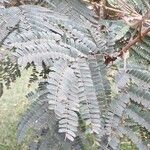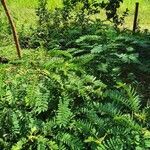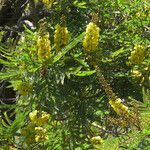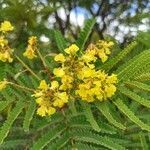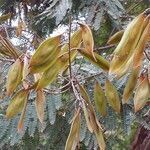A tree. It grows 10 m tall. It has a rusty brown covering over the plant. It does not have thorns. It loses many leaves during the year. The leaves are twice divided. There are 7 pairs of pinnae about 6 cm long each with 15 pairs of leaflets. These are 8 mm long by 3 mm wide. The flowers are in branching groups at the end of the plant. These are 20 cm long. There are many flowers close together. They are yellow. The fruit are flattened pods that taper to both ends. They are 7 cm long by 2 cm wide. There are about 2 seeds.
Leaves: petiole and rachis together 4–28 cm, densely brown-pubescent to-tomentose, sometimes with glands; pinnae 4–13(17) pairs; pinna rachis 1.5–8(10.5) cm; leaflets 6–28 pairs per pinna, (2)4–9(12) ×(1)1.5–3(4) mm, oblong or occasionally ovate-oblong, asymmetrical at the base, rounded to subacute at the apex, and mucronate; both surfaces appressed-pubescent; stipules up to 1.4 cm long, linear-subulate with up to 7 linear, alternate, lateral appendages to 6 mm long, the whole usually very quickly caducous.
Flowers in fairly dense, terminal and axillary racemes up to 24 cm long, usually grouped at the ends of branches to form a pseudopanicle, the axes densely brown-pubescent; bracts up to 7 × 1 mm, linear-lanceolate, caducous; pedicels 3–8(10 in fruit) mm excluding the receptacle.
Pods 4–9 × 1.4–2.6 cm, elliptic to narrowly elliptic, the wings down each margin 3–6 mm broad, the whole densely puberulent, or glabrescent at maturity, indehiscent; seeds 1 or 2, 9–12 × 5–8 × 1 mm, ± oblong, elongated longitudinally in the pod, with the hilum at one end.
Unarmed tree, up to 9 m high. Young branchlets and leaves rusty or greyish pubescent or tomentose. Leaflets: 8-22 pairs per pinna. Inflorescences racemose. Pods elliptic, 40-90 x 14-20 mm, acuminate at both ends. Flowers bright yellow.
With 10–28 pairs of leaflets per pinna which are mucronate at apex and about 0.3–1 (–1.2) cm. long and 0.1-0.45 cm. wide, and with pedicels at flowering time about 1–1 1/2 times as long as the calyx.
Petals 10–14(17) mm long, obtriangular-spathulate with a short claw, or the upper one somewhat shorter and with a broader and stouter claw, the distal margins all ± undulate, all yellow.
Young stems with rusty-brown to greyish, ± spreading tomentum or puberulence, sometimes also with stalked, swollen-headed glands, particularly on saplings [see note].
Sepals (4)5–6(7) mm long, brown-pubescent except on the scarious margins, ± reflexed in flowering.
Stamens 8–13 mm, shorter than the petals; anthers 1.5–2.75 mm long.
Ovary appressed brown-pubescent, often ± velutinous.
Small tree 3–9(14) m high, with a spreading crown.
